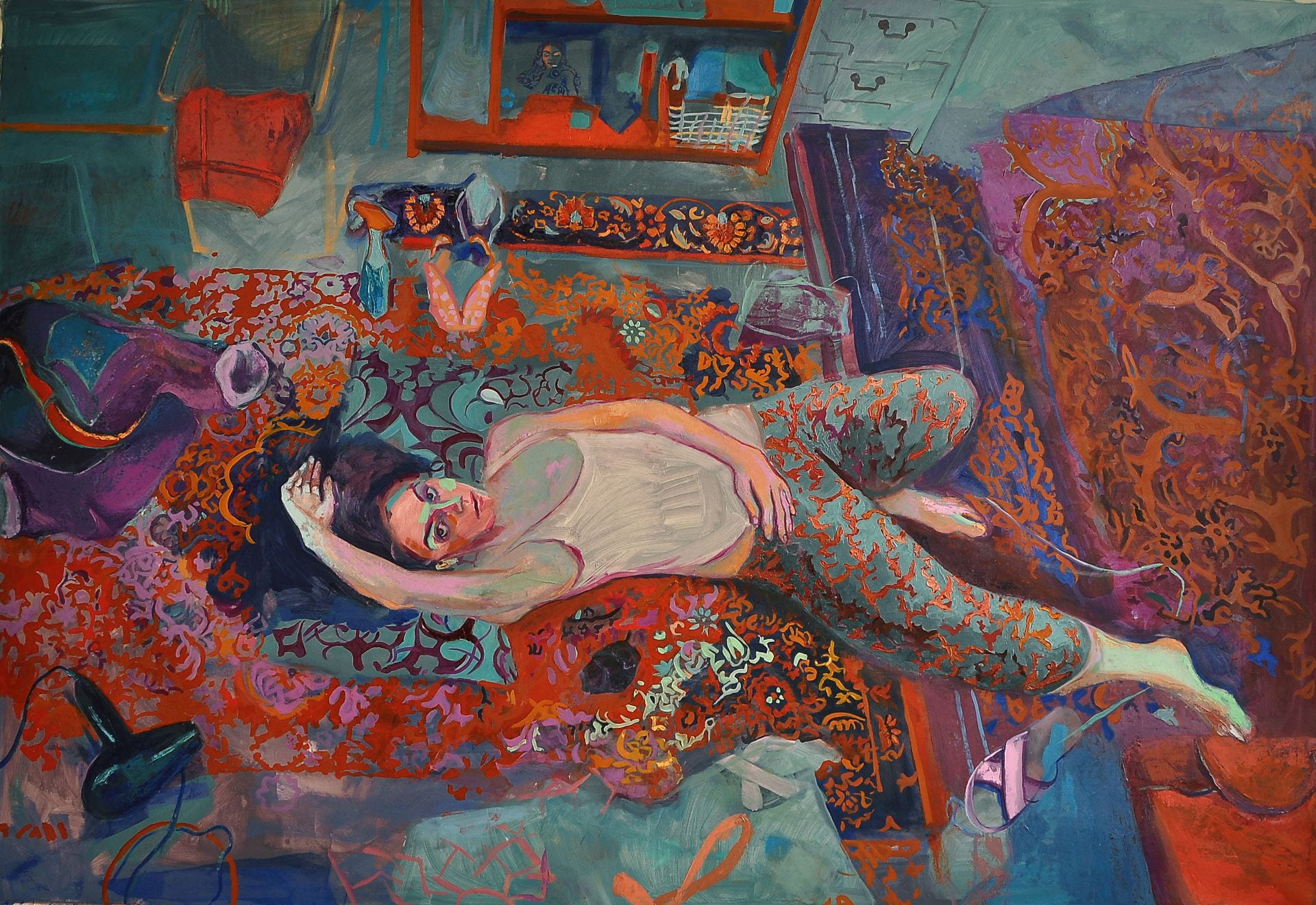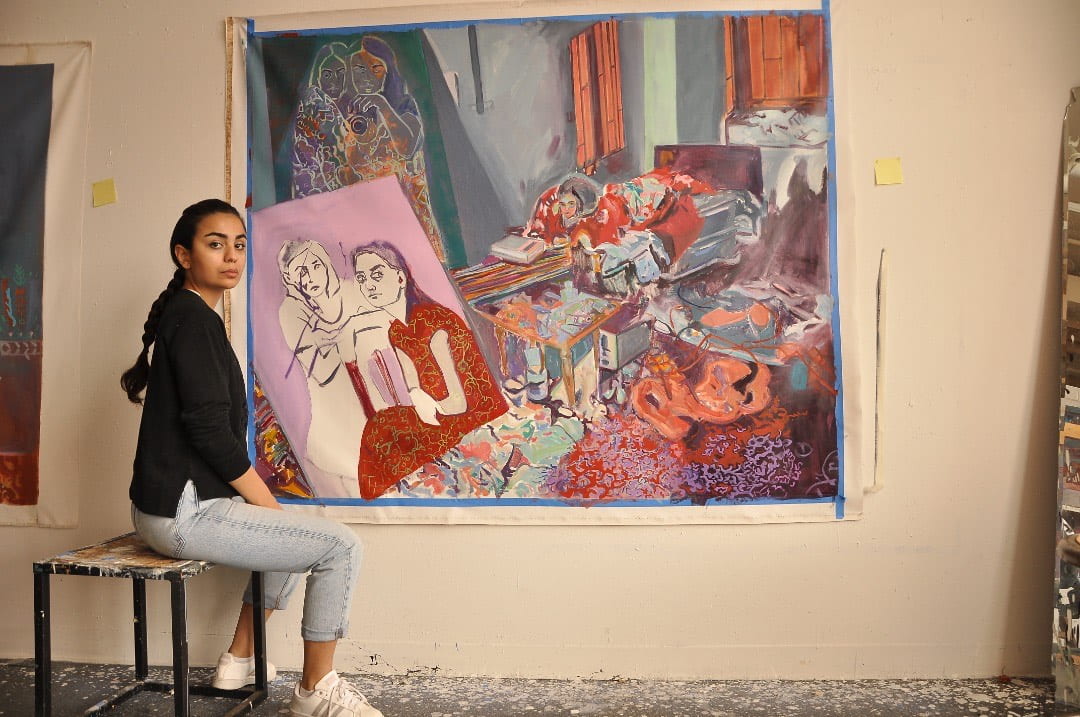Shabnam Jannesari is a third-year student and MFA Candidate in painting here at UMass Dartmouth. Jannesari is from Isfahan, Iran – an ancient city with spectacular mosques that are decorated with traditional tiles and Islamic patterns. She received her BA in painting from a University in Iran. “I search for Iranian elements such as the Persian carpet and traditional tiles in order to create a framework for my perceptions as well as celebrate the beauty of my home,” Jannesari says.
Her own life influences her work yet her ideas also tie back to the struggles of other Iranian women as a whole. “My paintings express my personal story, but they also reflect the life of Iranians and of all suppressed women,” Jannesari says. “I address the complexity of Iranian female identity in the imagery space that departs from reality. I am exploring the memories and nostalgia of distant intimacies in my life through narrative. I am creating imaginary spaces from personal reference and patterns. The use of pattern acts as a bridge between different elements of my paintings. By reinventing and creating imaginary space, I construct an abstracted world with highly emotive potential. My work will consist of large, highly saturated oil paintings with figures that are roughly life-size. Though I work with paint, I am interested to maintain the immediacy of drawing to avoid rendering my forms too closely. Working in this way allows me to experiment with form, color, and abstraction in the imagined spaces that I paint for my figures. This departure from reality is a protest of female suppression and creates a special and secret space against reality.”


Her childhood and culture also inspire her use of color in her work. “My bright, highly saturated palette is inspired by childhood memories, specifically a colorful carpet in my grandparent’s home in Iran,” she says. “I love the carpet’s warm colors and non-repetitive intricate pattern; I could stare at it forever. Michel Foucault writes, “The traditional garden of the Persians was a sacred space that was supposed to unite four separate parts within its rectangle, representing the four parts of the world, as well as one space still more sacred than the others, a space that was like the navel, the center of the world brought into the garden,” (Of Other Spaces: Utopias and Heterotopias).
Some of Jannesari’s favorite artists include Alice Neel, Shirin Neshat, Jennifer Packer and Doron Langberg. They have each influenced her work in different ways. “I admire Alice Neel because she changed the societal perception of women,” Jannesari says. “She did not represent women as a vulnerable, passive, and weak creature of the male gaze in Western art. She was able to change the concept of the female body from an idealistic appearance to a powerful one.”
Shirin Neshat is a contemporary Iranian visual artist best known for her photography, video, and film. Her work explores the political and social conditions of Iranian and Muslim life. She focuses primarily on women and feminist issues. “Neshat shows how the hijab in Iranian society is a tool for censuring and controlling women,” Jannesari says. “In her art, the gaze is alarming to the viewer because the veiled woman is staring directly back. She holds the attention of the viewer and takes the opportunity to display the violence and oppression in Iranian culture.”
Jennifer Packer is an award-winning American painter who lives in New York. “She makes skin color secondary to the psychological aspects of her models,” Jannesari explains. “Her use of soft hues of yellow, ochre, red, and mauve express an intimate emotional sensitivity even when the figure is doing something as mundane as hanging out on a couch in their apartment. In her compositions, eye contact engages the viewer. Packer’s paintings are rendered in loose lines and brushstrokes using a limited color palette, often to the extent that her subject merges with or retreats into the background. Suggesting an emotional and psychological depth, her work is enigmatic, avoiding a straightforward reading.”

Doron Langberg is an Israeli painter who now lives in Brooklyn. Langberg addresses issues of gender and sexuality in his paintings. “What I admire about his work is the variety of mark-making and technical approaches that he applies and combines within a single painting,” Janessari says. “He describes friendship or familial closeness. He searches for affinities between textures, marks or color relationships and moments.”
Jannesari enjoys watching movies in her free time. She plans to graduate in May 2021.
Though Jannesari is graduating soon, her work is just beginning. “I will continue to illuminate the plight of the Iranian woman – censored by an overreaching patriarchy. I will address the complex reality of Iranian female identity from my unique personal experience,” she says. “I have been applying for grants, shows, and exhibitions. Having exhibitions would offer me the opportunity to communicate with a greater audience and empower women. My work invites a dialog to reconsider assumptions about women who have been circumscribed by Islamic culture. I find that in America, society often misunderstands Islamic religion or Persian culture. Showing my work in public gives me the opportunity to connect with others and retell stories of Iranian culture from a personal viewpoint.”
You can learn more about Shabnam and her work by following her on Instagram at:
shabnam.jannesari

Wonderful goods from you, man. I have understand your stuff previous to
and you are just extremely magnificent. I really like
what you have acquired here, really like what you are stating and the way
in which you say it. You make it entertaining and you still
take care of to keep it smart. I can not wait to
read much more from you. This is really a great site.
What’s up, its fastidious article regarding media print, we all
understand media is a enormous source of data.